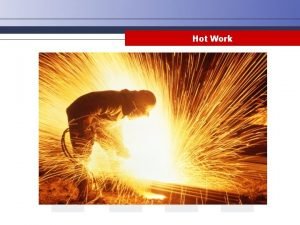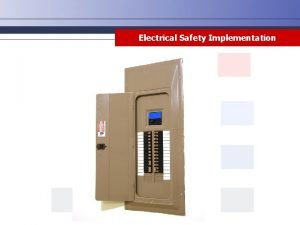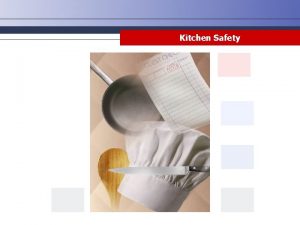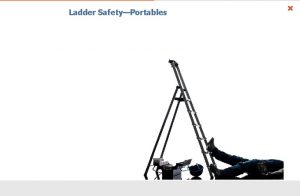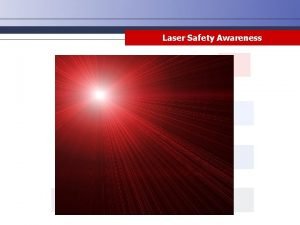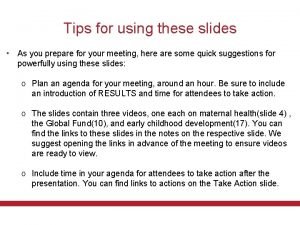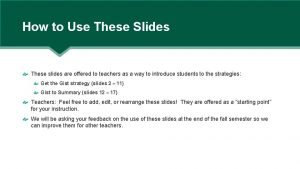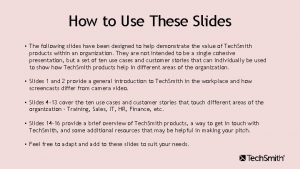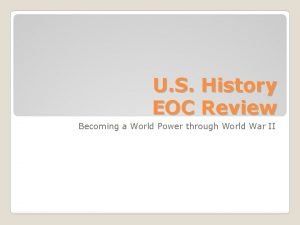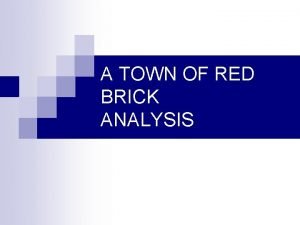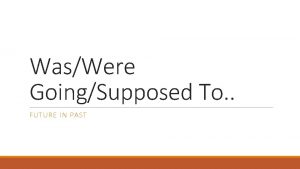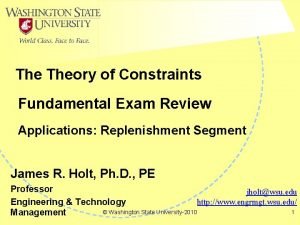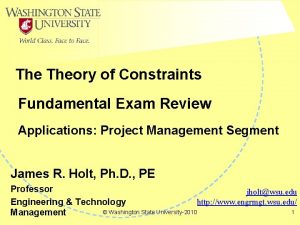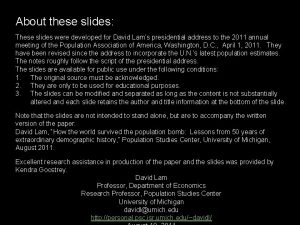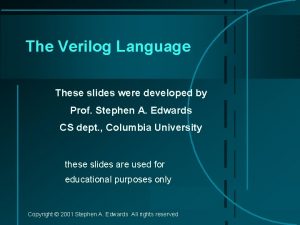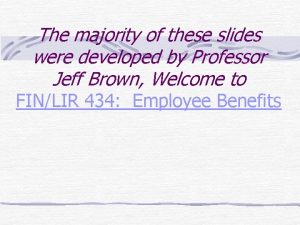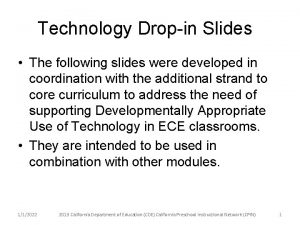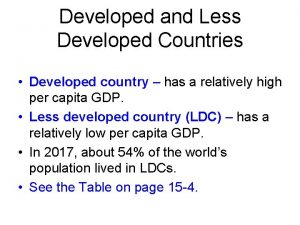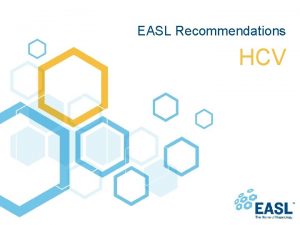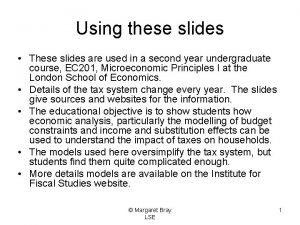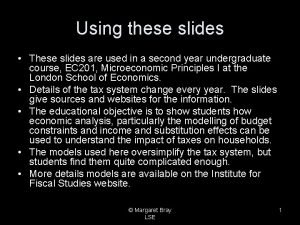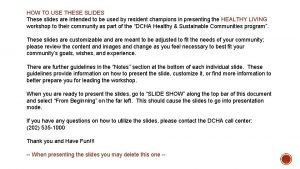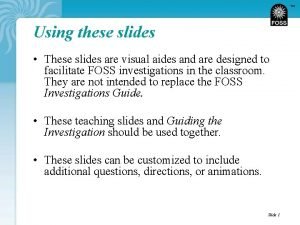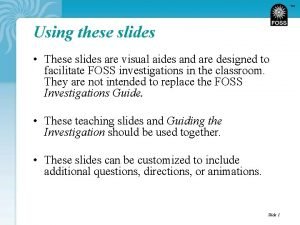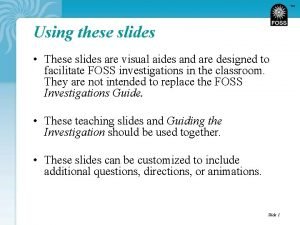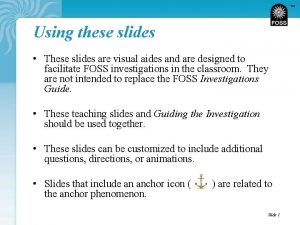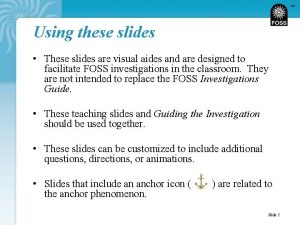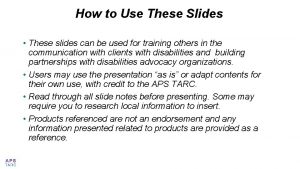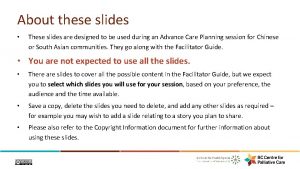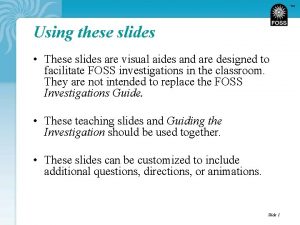Disclaimer The material in these slides were developed














































- Slides: 46

Disclaimer: The material in these slides were developed over time and represents Dr. Holt’s personal views and approach to TOC. It is not the view of Washington State University nor TOCICO. It may be dated, incomplete or absolutely wrong. While the text and figures in this presentation are helpful to facilitate teaching and discussion of these topics, without the words that go with the slides, the presentation is not complete and may not even make sense. This material is made available in the public domain as a service. Individuals may use this material as resources to teach their own TOC review seminars as long as they give reference to the source. There is no promise nor expectation that these materials are either necessary or sufficient to pass any of the TOCICO certification exams. Anyone using these materials should continue to study from the many other sources of excellent TOC literature available. In many cases, common knowledge is included here without reference. If you would like to improve any of these files, please do so. Your contribution will be included in future postings. Dr Holt. Theory of Constraints Fundamental Exam Review Finance and Measures Segment James R. Holt, Ph. D. , PE Professor jholt@wsu. edu http: //www. engrmgt. wsu. edu/ Engineering & Technology © Washington State University-2010 1 Management

TOCICO Segmented Fundamentals Exam Fundamentals Certificate Multiple Choice Exam (Identify, Exploit, Subordinate, Elevate, Go to Step 1) Fundamentals Certificate of TOC Philosophy • Inherent Potential • Inherent Simplicity • Inherent Win-Win • Five Focusing Steps • Three Questions Fundamentals Certificate of TOC Thinking Processes Fundamentals Certificate of TOC Applications TOC Finance & Measures • Conflict Cloud • DBR • Negative Branch • Project Management • Ambitious Target • T, I, OE • PQ Type Problem • Replenishment © Washington State University-2010 2

Topics in TOC Finance & Measures • Purpose of Finance (invest in improvements) • Purpose of Measures (keep everyone focusing on the • • constraint and subordination) Decide on Investment decision (make/buy, equipment purchase) Impact of poor quality/delivery on system Impact of poor inventory practices on the system Financial Buffer Management T, I, OE, Cash Flow, Profit, Return on Inventory/Investment TDD, IDD Throughput Accounting worksheet © Washington State University-2010 3

Finance Processes The Goal: Make Excellent Investments The Measure: Systems Profit, Inventory, Operating Expense The Constraint: Knowing What to Do Cost of Raw $ Materials $ $ Cost of Labor T I OE Cost of Equipment Cost of Operations $$$$$ Cost of Marketing $$$ Cost of Management Cost of Expansion Cost of Projects Wait? © Washington State University-2010 $ $ 4

Finance Processes The Conflict Cloud: T The Paradigm Shift: Focus on ΔT, ΔI & ΔOE Relative to the Constraint B. Excellent System wide I OE $$$ D. Consider everything effected A. Excellent Investments C. Excellent use of Constraint © Washington State University-2010 D’. Consider only T, I, OE 5

The Finance Results Every Investment is an Improvement: T I OE OE Cash Flow Improves. Profit Improves. Return-on-Investment Improves. Indebtedness Reduces. Confidence, Security and Predictability Improves. Freedom of Actions Dramatically Improves. © Washington State University-2010 $$$ What do we learn here to apply to Daily Lives? 6

Financial Lessons Learned • Manage Costs Relative to the Constraint. • Pick High T/Constraint Unit Projects • Determine Needs Prudently § Know the difference between Needs and Wants • Stop Buying Junk (no payback) • Be Frugal Everywhere but at the Constraint (Spend what it takes to improve the Constraint wisely) • Avoid Un. Necessary Debt (Earn Interest vs. Paying It) • Have Cash and Other Financial Reserves • Simplify Life and Decisions become easier © Washington State University-2010 7

Consider a Simple Firm WXYZ • Only two employees: Mr. M and Mr. N • They can choose between any one of Four Products: W, X, Y, or Z • Unlimited materials and unlimited market demand • They each get paid $10 per hour. • The Firm operates 8 hours a day. • They get paid whether they produce anything or not. © Washington State University-2010 8

Work Flow © Washington State University-2010 9

Cash Flow Summary © Washington State University-2010 10

So, What Product Should They Make? • Decision suggested by Accounting: Produce items with the HIGHEST PROFIT MARGIN • That would be Z with a $26. 17 Profit Margin selling at $52 each • ($52)*(16 ea) - ($20)*(16 ea) - (2 workers)*(8 hours)*($10/hour) = $352 /day © Washington State University-2010 11

What about Marketing • Decision suggested by Marketing: Produce items with the HIGHEST SELLING PRICE (paid on Commission) • That would be Y at $55 Sales Price Each • ($55)*(16 ea) - ($25)*(16 ea) - (2 workers)*(8 hours)*($10/hour) = $320 /day © Washington State University-2010 12

What about Production? • Decision suggested by Production: Produce items that keep machine at HIGHEST EFFICIENCY • That would be X at $50 profit each • ($50)*(24 ea) - ($25)*(24 ea) - (2 workers)*(8 hours)*($10/hour) = $440 /day © Washington State University-2010 13

But, If We Think Globally! • Decision based upon producing items that provide the MOST THROUGHPUT PER UNIT OF CONSTRAINT TIME for the SYSTEM • That would be W at $50 profit each • W: ($50)*(24 ea) - ($20)*(24 ea) - (2)*(8)*($10) = $560 /day © Washington State University-2010 14

Product Option Summary • Does it really make any difference what you choose to do? • Mr. N is 100% busy for every product! That’s 100% efficiency! You can’t get better than that, can we? • Product Profit/Day Compare • Acctg-Profit Margin Z $352 100% • Sales-Hi Sales Price Y $320 90% • Production-Efficiency X $440 125% • TOC Measure W $560 159% © Washington State University-2010 15

Worse Effects from Non-Global Thinking • What we have to put up with: • Decisions are based on combined opinion of accounting, production and sales. § That is, “They change decisions weekly!” • Shop is measured on performance/efficiency § Shop floor struggling for efficiencies. So, we produce extra when machines running. We pull jobs out of sequence. We shift parts ahead or back to meet efficiency quotas. Out of Synch. © Washington State University-2010 16

The Resulting Effects of Non-Global Thinking • Product Group finds we have high efficiencies and yet our production is unacceptable to meet objectives. § Use overtime to improve numbers • Plant Manager sees frequent overtime, late shipments, long queues. Orders additional capacity (more machines, out sources work). § Increases costs to produce more of the low throughput products. § Reduces the profit of the firm. © Washington State University-2010 17

TOC Measures: T, I, OE • We have touched on measures and their impact. It’s time to properly define then and work through and example that shows how valuable using the right measures can be. § Throughput (T): “The Rate at which the System Generates Income” ( (This is Sales Price-Truly Variable Cost)/Time). It is often referred to as Octane: The income/unit of constraint for a particular product. Priority 1 § Inventory (I): “The things we buy with the intent to sell” (Sum total of the costs spent in buying things up and until the moment someone actually pays us for them). Dollar-Days is I*Number of days held. Priority 2 § Operating Expense (OE) The cost of converting “I” into “T”. All costs associated with the business lumped into one. Labor is OE. Don’t be confused by using allocated costs. Costs may be good for reporting, but not for managing. A low priority 3 § Profit (P): T-OE § Return on Investment (ROI): (T-OE)/I § Cash Flow (CF): “Is there money on hand to pay what we need to do? ” © Washington State University-2010 18

Basic Measures • T= (Sales - Truly Variable Costs)/time (T is a rate) • I = Things we buy with the intent to turn them to T • OE=All costs of turning I into T • Profit=T-OE • Return on Investment = (T-OE)/I • Cash Flow=T-OE >0 (more in than out) (poor cash flow can only be supported by increasing loans for so long) © Washington State University-2010 19

Trial Problem (PQ) • Now we know what to measure, lets take a case. This case • • is described in The Haystack Syndrome (shifting information out of Data) by Eli Goldratt Four employees (A, B, C, D) work to make either of two products (P, Q). They buy raw material and perform operations. Each employee performs two different operations. The production pattern (routing plan) for the two possible products follows on the next slide. Each employee works 8 hours a day, 5 days a week. At the end of the week, Operating Expenses are $6000 which includes labor and overhead. Which product should they make? Or, how many of each one should they make? How many can they make? 20 © Washington State University-2010

Final Goods P and Q available to Customers Materials Flow Diagram D makes the assembly for P including a purchased part Work flows upwards from RM to Assembly operation by worker D Note: The middle common part produced by worker C is used in both Product P and Q Worker: Process Time in Minutes Three types of Raw Material and Purchase Prices © Washington State University-2010 21

Some Typical Cost Accounting Numbers to Assist your Decision © Washington State University-2010 22

A Few More Numbers Before you go on, take a shot at filling out the form below. How many Ps should be made? How many Qs? Commit yourself before you look at the solution on the following pages. (Go back a few slides if you need to, but don’t look ahead. If you cheat, you won’t learn as much as you should. ) © Washington State University-2010 23

Well? Q looks tempting. Try making Q first. All we can make with the time remaining All market wants © Washington State University-2010 24

Well then, Try P first All market wants All we can make with the time remaining © Washington State University-2010 25

Consider Traditional Measures • Sales Price: Q $100 P $90 • Margin: Q $ 28. 50 P $ 7. 20 • Raw Material: Q $ 40 P $45 • Labor: Q 50 Min P 60 Mins • Throughput: Q $ 60 P $ 45 • Quantity Q 50 ea. P 100 ea. Should sell Q Should Sell Q Should Sell P What is missing? Where is the Constraint? Octane! Throughput / Constraint Minute! © Washington State University-2010 26

What is the Difference? • Consider the Constraint worker B. The constraint is 100% Busy no matter what we choose. But… • Individual Throughput for P is $90 -45=$45 • Individual Throughput for Q is $100 -40=$60 • Octane for P is T/time=$45/15=$3/min • Octane for Q is T/time=$60/30=$2/min • Producing P versus Q delivers $1 per minute difference. So, if we can’t make all Ps and all Qs, we should not waste our precious constraint time making Qs at the expense of Ps. • Be sure to make all Ps and then make as many Qs as you can. © Washington State University-2010 27

Now you are proficient with TOC Measures. . . • Lets consider a series of possible changes that could occur to our PQ factory. • What would you recommend if: § You could rent a Jig to speed up worker A? § You could rent a Jig to speed up worker B? § You could buy the Left RM with the first process already complete? § If you could buy the Center RM with the first process already complete? § Should we add a new product O? § Should we add a new product R? © Washington State University-2010 28

Consider Alternative 1: Jig for A • • • New Jig works at both A locations. Saves 5 minutes at each A operation Rental cost only $100 per week Saves (5*100 +5*30)= 630 Minutes at $0. 63 = $400 Reduces OE by $400 Wow! $400 -$100=Saved $300 Dollars! Really? What happened to the OE really? § Did it go down? § Or did it go up as we added equipment rental costs? © Washington State University-2010 29

Consider Alternative 2: Jig for B • • Only works at middle B operation. Costs $200 per week Only saves 2 minutes on one operation Saved time (2*130) = 260 minutes Reduced OE: 260 Minutes @ $0. 63 = $165 Looks pretty bad Really? What happens when we reduce the time required on the Constraint? § Now many components flow through that operation? (100 P + 30 Q = 130) § How much time is gained? 2*130=260 minutes. § How many more Qs can we make? § 260/30=8 with T of $60 each = +$480! © Washington State University-2010 30

Consider Optional Raw Material Purchase • Suppose we could purchase the left Raw Material Pre • • • Processed to eliminate the Left A process Cost only $5 extra each * 100 each or $500 Savings 15 Minutes * 100 = 1500 Minutes @ $0. 63 = $950 Looks Real Good! Really? Does it save any overhead at all? § We must continue to have A working, so nothing gained. § And, we increase overhead by $500. © Washington State University-2010 31

Consider Optional Raw Material Purchase • • • Now consider the option of purchasing the Middle Raw Material Pre Processed to bypass the Middle B process Cost only $10 each extra * 130 each or $1300 Savings 15 Minutes * 130 = 1950 Minutes @ $0. 63 = $1230 Doesn’t look too good! Should you do it? YES! WHY? § For only $10 extra, we gain 15 minutes of Constraint time. That costs $0. 66 per minute. § We can earn $2. 00 per minute making more Qs § We need 600 more minutes to make all Qs. § So, we buy 40 of the pricey Middle RMs (But no more). © Washington State University-2010 32

Consider Adding a New Product O Sells for $40 RM is $25 Overhead $15. 75 • We can add a new product O Looks like - $0. 75 • O doesn’t flow through the constraint. A Loss in Profit! • Just uses the left side of the plant A and C O • Also uses $5 purchased part. • What do you think? • Is it a Cheeri- O ? • We can make lots of Os and sell them at anything above $25. © Washington State University-2010 33

O O Sells for $40 RM is $25 Overhead $15. 75 Looks like a $0. 75 Loss in Profit Octane on O is $15/0=$ We should make O. We can make up to the point A can no longer support or other operations. Cheeri-O! © Washington State University-2010 34

Consider Adding a New Product R Sells for $40 • We can add a new product R • R flows through the constraint • on the Right. Just uses the right side of the plant A and B What do you think? • • Is it a lose- R ? © Washington State University-2010 RM is $20 Overhead $15. 75 Looks like a winner at $4. 75 Profit! R 35

R R Sells for $40 RM is $20 Overhead $15. 75 Looks like a winner at $4. 75 Profit! Octane on R is $20/15=$1. 33 We should Not make R. The Octane for Q is $2. 00 per minute. It’s a Lose-R! © Washington State University-2010 36

Putting T, I OE in Practice • Suggest using a simple form: • Option____________ Date _______ • Proposal by _________ $K/yr Sales $K/yr - Materials $K/yr = Throughput -Operating Expense = Profit $K/yr Current Change Future Refn: Theory of Constraints and Its Implications for Management Accounting, Western Textile. © Washington State University-2010 37

Putting T, I OE in Practice • (Simple form continued) Current $K/yr Profit $K Inventory $K + Accts Receivable $K - Accts Payable $K = Working Capital $K + Fixed Assets $K = Assets $K/yr Profits $K ÷ Assets ROA Change © Washington State University-2010 Future 38

Putting T, I OE in Practice • (Simple form continued) $K $K/yr # $K/E/yr Current Change Future = Assets Profits ÷ Assets ROA Profits ÷ Employees ROE © Washington State University-2010 39

TOC Marketing Approach Goal Items $ Throughput -> $$ $$ High Profit High Velocity! on $$$$ i t ec ir D g Good Solid Products $$ tin e t Ne k ar Goal M Low Profit High Volume $$ $$ $0 Low -> Volume of Sales -> High -$ Look for High Octane ($/min) Needed to flesh out market offer -$ Required to obtain a related good product. © Washington State University-2010 40

A Word about Inventory? Number of problems • Inventory is a big part of subordination. • Is too much Inventory Bad? • Is too little Inventory Bad? • Which is worse? Low Amount of Inventory High © Washington State University-2010 41

Subordinate Inventory • Having Inventory is not the Goal. • Inventory is what we buy with the intention of converting it to Money • Move inventory to where it will do some good. • Move Inventory Quickly to the Constraint (Keep Buffer close to Constraint) • Move Inventory Quickly away from the Constraint (quickly convert inventory to money) • Think “Protection of the System” when you think of inventory. © Washington State University-2010 42

Economic Order Quantity Cost of Operation $ Ordering Costs (D/Q)*Cost Ordering Total Cost=(D/Q)*Cost Order +(Q/2)*Cost Holding Costs (Q/2)*Cost Holding Small Order Quantity Q © Washington State University-2010 Large 43

Solving for Q at Optimal Position Cost of Operation $-> Optimal Order Quantity Small Large Q= ((2*D*Co)/CH/h)**0. 5 Order Quantity Q © Washington State University-2010 44

Low Investment Small Order Quantity Q High Large Cost of Operation $-> Profit Measure-> For the Same Profit, Invest a little in Inventory or Alot? © Washington State University-2010 45

Next Topics • TOC Thinking Processes • TOC Applications § Operations § Project Management § Replenishment • TOC Finances and Measures • Some TOC Philosophy will be blended into these additional topics. © Washington State University-2010 46
 A small child slides down the four frictionless slides
A small child slides down the four frictionless slides Starting from rest a marble first rolls down
Starting from rest a marble first rolls down Disclaimer for training material
Disclaimer for training material Disclaimer for training material
Disclaimer for training material Disclaimer for training material
Disclaimer for training material Ladder types ratings
Ladder types ratings Disclaimer for training material
Disclaimer for training material These slides
These slides These slides
These slides Following slides
Following slides Gd & t symbols
Gd & t symbols Idle time meaning in cost accounting
Idle time meaning in cost accounting Relativism
Relativism Whats cultural lag
Whats cultural lag Material and non material culture examples
Material and non material culture examples Examples of household materials useful and harmful
Examples of household materials useful and harmful World power era eoc blitz review
World power era eoc blitz review It was a town of red brick
It was a town of red brick Future in the past was were going to examples
Future in the past was were going to examples Hình ảnh bộ gõ cơ thể búng tay
Hình ảnh bộ gõ cơ thể búng tay Frameset trong html5
Frameset trong html5 Bổ thể
Bổ thể Tỉ lệ cơ thể trẻ em
Tỉ lệ cơ thể trẻ em Gấu đi như thế nào
Gấu đi như thế nào Glasgow thang điểm
Glasgow thang điểm Bài hát chúa yêu trần thế alleluia
Bài hát chúa yêu trần thế alleluia Các môn thể thao bắt đầu bằng tiếng bóng
Các môn thể thao bắt đầu bằng tiếng bóng Thế nào là hệ số cao nhất
Thế nào là hệ số cao nhất Các châu lục và đại dương trên thế giới
Các châu lục và đại dương trên thế giới Công thức tính thế năng
Công thức tính thế năng Trời xanh đây là của chúng ta thể thơ
Trời xanh đây là của chúng ta thể thơ Cách giải mật thư tọa độ
Cách giải mật thư tọa độ Làm thế nào để 102-1=99
Làm thế nào để 102-1=99 Phản ứng thế ankan
Phản ứng thế ankan Các châu lục và đại dương trên thế giới
Các châu lục và đại dương trên thế giới Thơ thất ngôn tứ tuyệt đường luật
Thơ thất ngôn tứ tuyệt đường luật Quá trình desamine hóa có thể tạo ra
Quá trình desamine hóa có thể tạo ra Một số thể thơ truyền thống
Một số thể thơ truyền thống Bàn tay mà dây bẩn
Bàn tay mà dây bẩn Vẽ hình chiếu vuông góc của vật thể sau
Vẽ hình chiếu vuông góc của vật thể sau Nguyên nhân của sự mỏi cơ sinh 8
Nguyên nhân của sự mỏi cơ sinh 8 đặc điểm cơ thể của người tối cổ
đặc điểm cơ thể của người tối cổ V cc cc
V cc cc Vẽ hình chiếu đứng bằng cạnh của vật thể
Vẽ hình chiếu đứng bằng cạnh của vật thể Phối cảnh
Phối cảnh Thẻ vin
Thẻ vin đại từ thay thế
đại từ thay thế


